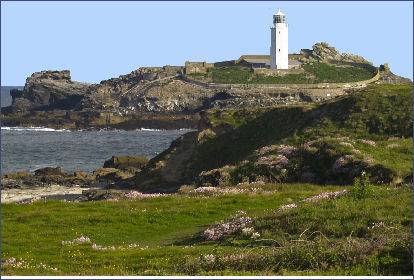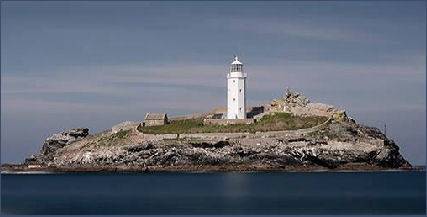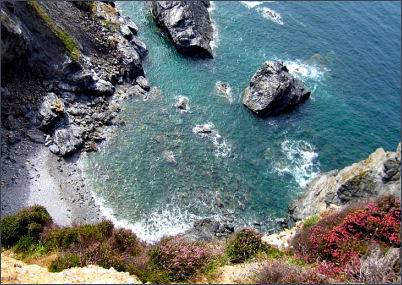Godrevy Head
OS grid ref:- SW 580430
 Spectacular Godrevy Head, which is owned by the National Trust, lies on Cornwall's Atlantic coast, and is situated half a mile from the village of Gwithian.
Spectacular Godrevy Head, which is owned by the National Trust, lies on Cornwall's Atlantic coast, and is situated half a mile from the village of Gwithian.
Nearby is an area of heath known as the Knavocks which is also managed by the National Trust. The grassland and gorse scrub is crossed by several footpaths and is home to many species of butterflies and birds, notably nesting stonechats. The Knavocks, like other coastal heathlands in Cornwall, is managed by regularly cutting back the gorse and by grazing.
Godrevy beach is one of the best surfing beaches in Cornwall and often picks up a westerly swell when other places are flat to very small The beach is lined by rocks which house many rock pools. At low tide it is connected to Gwithian beach forming an impressive stretch of sand.
Godrevy Point is best known for the large Grey Seal colony in Mutton Cove, .sightings of dolphins and porpoises are reported frequently. Basking Sharks and Oceanic Sunfish are also occasionally seen.
The rocky outcrops and cliffs are magnificent. Just offshore is Godrevy Island, which was the scene of the famous shipwreck of the Garland, a 700 ton Steamer, in 1649. In the aftermath of the execution of King Charles I, followers attempted to send his lace trimmed garments abroad for safe keeping as relics of the 'Martyr King', together with some personal belongings of his exiled Queen Henrietta Maria of France and the wardrobe of Charles, Prince of Wales (later Charles II).
 The ship was wrecked while taking shelter off St Ives in a great storm and dragged her anchors. Only a man, boy and wolf–dog survived out of about sixty passengers and crew and only a few of the clothes were washed ashore.
The ship was wrecked while taking shelter off St Ives in a great storm and dragged her anchors. Only a man, boy and wolf–dog survived out of about sixty passengers and crew and only a few of the clothes were washed ashore.
Godrevy Lighthouse
Godrevy lighthouse was constructed in 1859 to protect shipping from a hazardous reef known as the the Stones which extends across the bay in the direction of St Ives. Prior to the building of the lighthouse, the Stones reef had wrecked The Nile, a passenger streamer, in December 1854, causing the loss of many lives.
The lighthouse if a white octagonal tower, rising to 86 feet high and bult of rubble stone. The original light was a revolving white one. with a fixed red light below the main light, which could be seen over a 45-degree arc when a ship was in danger of the reef.
The now solar powered lighthouse is automatic and is controlled by Trinity House. It is believed to have been an influence in Virginia Woolf's novel 'To the Lighthouse'. Although the book is set in the Hebridean Islands, as a child Virginia Woolf regularly holidayed with her family in St Ives.
A walk from Godrevy Head to Hell's Mouth
Distance: 5 miles (8 kms)
Duration- Around 3 hours
 (1) Starting from the National Trust car park by Godrevy café (OS grid ref- SW 583 423) walk to the towans or sand dunes) then proceed walk towards the lifeguard hut.
(1) Starting from the National Trust car park by Godrevy café (OS grid ref- SW 583 423) walk to the towans or sand dunes) then proceed walk towards the lifeguard hut.
(2) Bear right and follow the path along the clifftop. Continue along the track passing steps down to the beach and a small parking area on your right.
(3) The path joins with the road briefly and then carries straight on where the road bends to the right. Follow the coast path along the cliffs aboce Godrevy Cove.
(4) Turn right by the path to the beach and head through the field. Cross over the stone stile and carry on up the slope towards the headland.
(5) Allow the lighthouse to guide you up on to Godrevy Head. Continue to follow the coast path, with the sea on your left and fields on your right. Pass through the gate onto the Knavocks and continue along the track through heathland. Cross a wooden stile, followed by a stone stile and walk through the field, over the stone stile by the farm gate and on to a wide track.
(6) Towards the end of the track turn left through granite gateposts and follow the path close to the cliff edgewhich gradually drops down towards panoramic Hell's Mouth (pictured above left). Continue down the slope to the dramatic rocky inlet at Hells Mouth.
(7) Retrace your steps to return.